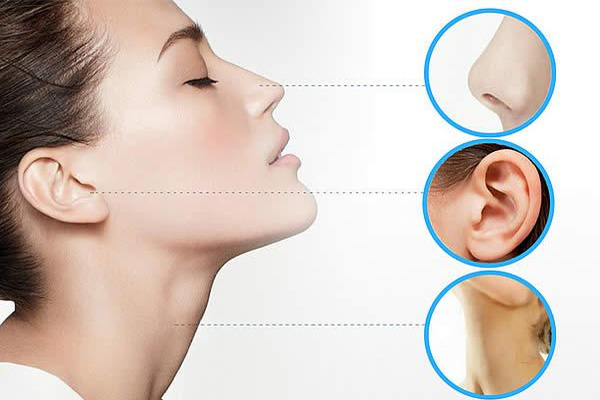Otorhinolaryngologists (also known as otolaryngologists or ear, nose and throat or ENT Surgeons) are surgical specialists who diagnose, evaluate and manage a wide range of diseases of the head and neck, including the ear, nose and throat regions.
ENT surgeons often treat conditions that affect the senses such as hearing and balance disorders or smell and taste problems. They also treat patients with conditions that affect their voice, breathing and swallowing as well as those with head and neck tumours including the skull base and interface with the brain.
ENT surgeons may treat people of all ages from newborn babies to elderly people. They see more children than most other surgeons, apart from paediatric surgeons. One of the attractions is that they treat a wide spectrum of ages and diseases.
A proportion of an ENT surgeon’s time is spent in outpatient clinics and managing conditions medically without the need for surgery. The use of microscopes & endoscopes in outpatients allows treatment/ diagnosis in the clinic. ENT has possibly the widest range of operations of any speciality from major head & neck procedures with flaps & complex reconstructions to microsurgery on the ear.
ENT surgeons treat a very wide range of conditions. These include:
- ear conditions
- nose conditions
- throat conditions
- head and neck conditions
- facial cosmetic surgery
Ear conditions include:
- otosclerosis (a condition of the middle ear that causes hearing loss) and other problems with hearing and deafness
- otitis media with effusion – a common condition of childhood (also known as glue ear) in which the middle ear becomes blocked with fluid
- age related hearing loss
- tinnitus (ringing in the ears) and eustachian tube dysfunction
- dizziness and vertigo
- ear infections
- perforated ear drum and cholesteatoma
- protruding ears
Nose conditions include:
- sinus infection and rhino-sinusitis, including in children
- nasal injuries
- nasal polyps
- tumours of the nose
- nasal obstruction
- disorders of the sense of smell
Throat conditions include:
- adenoid problems – surgical removal of these small glands in the throat at the back of the nose is sometimes needed, and is usually performed in childhood
- tonsillitis, sometimes requiring surgical removal of the tonsils, usually in childhood
- hoarseness and laryngitis
- swallowing problems
- upper airway breathing problems
- snoring and obstructive sleep apnoea (when breathing stops during sleep)
Head and neck conditions include:
- cancer affecting the mouth, oral cavity, throat (pharynx), voice box (larynx), salivary glands, skull base, or the nose and sinuses
- thyroid and parathyroid problems
- facial skin lesions including skin cancer
Facial cosmetic surgery is also part of ENT surgery and includes:
- rhinoplasty (nose surgery)
- otoplasty (ear surgery)
- blepharoplasty (removal of excess skin and fat pads around the upper and lower eyelids)
- facial reconstruction following trauma or cancer
Common procedures
ENT surgeons use many different surgical procedures including:
- insertion of grommets for glue ear – this involves a very small incision in the ear drum and is typically carried out on children. The grommets help to ventilate the middle ear and resolve middle ear effusions
- tonsillectomy (removal of tonsils) or adenoidectomy (removal of adenoids), most often in children
- septoplasty – correction of nasal septum to prevent obstruction and enable clear breathing
- microlaryngoscopy – a short metal tube (laryngoscope) is inserted into the larynx (voice box). This is used for examination and can also be used to perform a biopsy or surgery
- oesophagoscopy – a long metal or flexible tube (oesophagoscope) is inserted through the mouth into the oesophagus
- endoscopic sinus surgery – a tiny telescope is inserted into the nasal passages to diagnose and treat difficult sinus conditions. Technically refined instruments are then used to restore proper function
- tympanomastoid surgery to reconstruct and remove epithelial inclusions (cholesteatoma) within the middle ear
- open operations to remove neck lumps, and salivary gland tumours
- tracheostomy
ENT surgery has been at the forefront of the latest medical technologies and minimally invasive procedures are common. This has many benefits including less scarring and shorter recovery periods
Sub-specialties
Most ENT surgeons develop a sub-specialty and these include:
- otology – diagnosis and treatment of infection, disease and damage to the ear to improve hearing and balance. This includes cochlear implant surgery, which is the implantation of a small complex electronic device in to the inner ear (cochlea) which stimulates the auditory nerve. This can provide a sense of sound for deaf people
- rhinology – treatment of all aspects of nose and sinus disorders including allergy, infection, inflammatory conditions and tumours. Specialists will also operate on rare tumours of the skull base including pituitary tumours.
- laryngology – treatment of diseases and disorders of the larynx and throat, such as vocal fold nodules, voice problems (including overuse/misuse) and cancer
- head and neck surgery – the treatment of benign and malignant diseases of the head and neck, including lymph, salivary, thyroid and parathyroid glands
- skull base surgery/neurotology – treatment of disorders of the skull base and acoustic neuromas (benign, non-cancerous growths on the vestibulocochlear nerve which controls hearing and balance)
- facial plastics – aesthetic procedures including rhinoplasty (correcting and reconstructing the form, function and aesthetic appearance of the nose) and pinnaplasty (correction of protruding ears). The work also includes reconstruction of facial defects. Plastic and oral and maxillofacial surgeons may also perform this type of surgery
- thyroid and parathyroid surgery – diagnosis and surgical treatment of thyroid and parathyroid tumours
- paediatrics – some ENT conditions are congenital and treatment is needed at a very young age. Treatments are wide ranging and include cochlear implants and other implantable hearing devices, head and neck surgery and treatment for rare conditions including choanal atresia (where the back of the nasal passage is blocked by bone or tissue)
